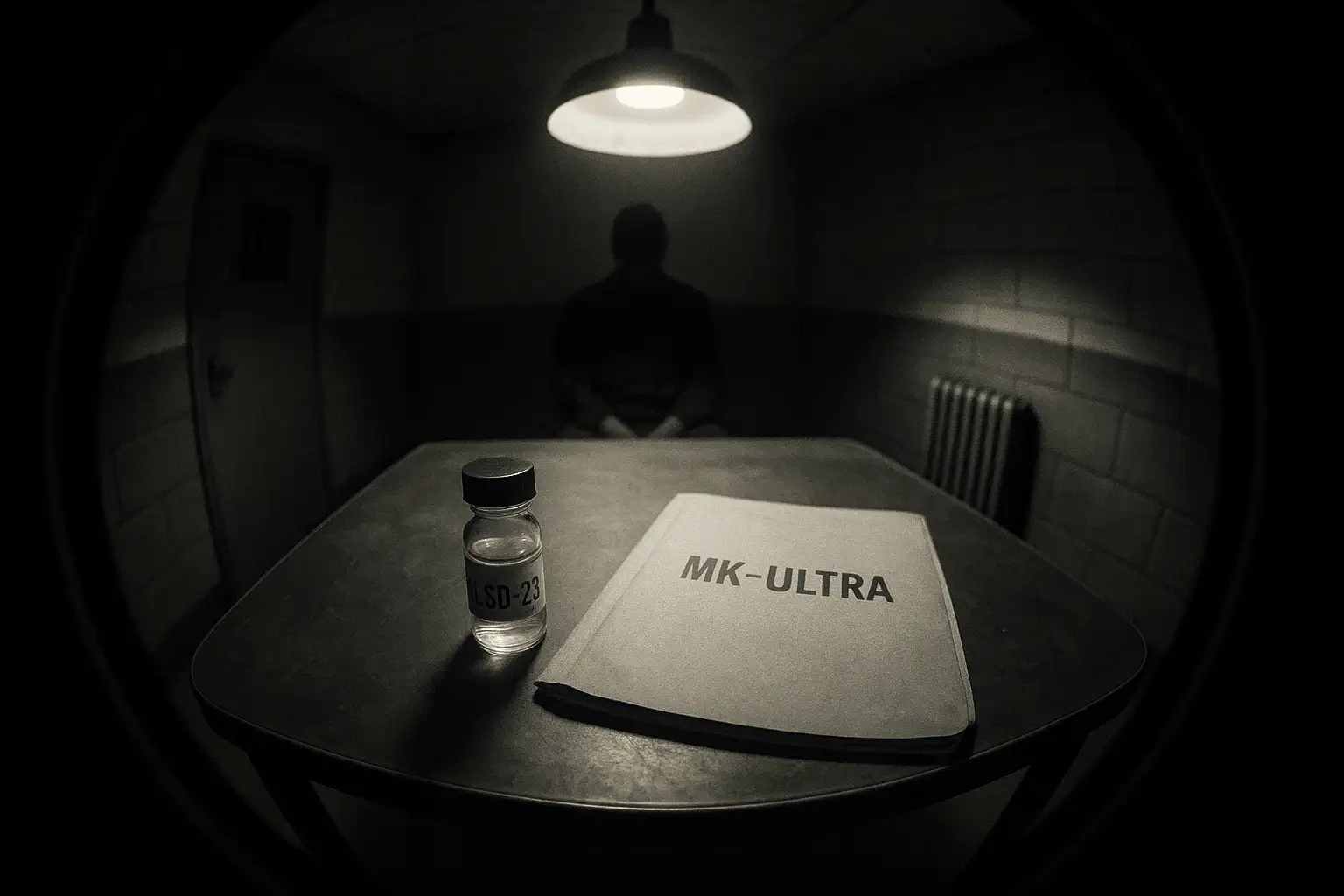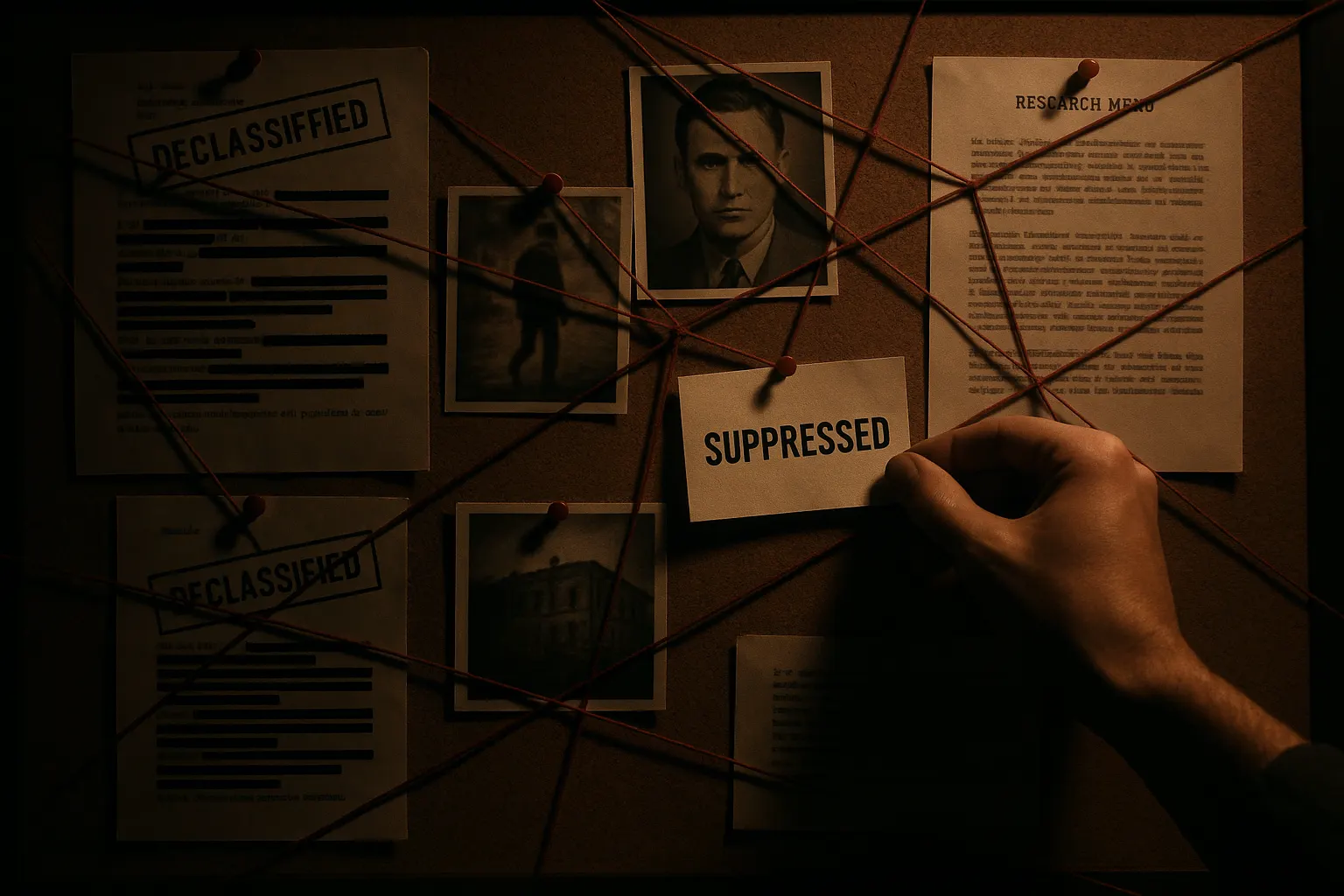In 1963, Harvard expelled two professors for asking the wrong questions. By 1973, psychedelic research was in ruins – careers destroyed, evidence erased, and a whole dimension of consciousness exploration buried. This wasn’t caution, it was containment. Why was it so important to shut this down?
The Harvard Expulsion – Where It All Began
The year 1963 marked the beginning of the end for legitimate psychedelic research in American academia.
When Harvard University dismissed Timothy Leary and Richard Alpert (later Ram Dass) from their positions, it was not simply an administrative decision – it was the opening salvo in what would become a decades-long campaign to erase consciousness research from the mainstream scientific landscape.
The official reasons seemed straightforward enough. Leary and Alpert had violated university protocols, conducted research under the influence of the substances they were studying, and allegedly given psilocybin to an undergraduate student. Their methodology was unorthodox, their approach cavalier; but beneath these ostensible violations lay something more unsettling – the fear that their research might actually be working.
The Harvard Psilocybin Project had explored the therapeutic potential of psychedelic substances with remarkable results.
Reports spoke of profound psychological breakthroughs, mystical experiences that seemed to facilitate genuine healing, and insights that challenged the very foundations of conventional psychology. But, as Leary would later reflect, “We were naïve enough to announce our findings publicly.”
The dismissal sent shockwaves through academic circles. If Harvard, the bastion of intellectual freedom and scientific inquiry, could so easily eject tenured professors for exploring unconventional avenues of consciousness research, what hope did smaller institutions have?
The message was clear – certain questions were not to be asked.
The Unspoken Fear: Was it the unorthodox methods or the unsettling prospect of genuine breakthroughs that truly sealed the fate of the Harvard Psilocybin Project?
The Sandoz Withdrawal
Two years later, in 1965, another crucial pillar of support collapsed. Sandoz Pharmaceuticals, the Swiss company that had supplied LSD to researchers worldwide for over a decade, abruptly withdrew its sponsorship of all psychedelic research.
This was not a gradual scaling back; it was an immediate, total cessation that left scientists scrambling for alternatives.
The timing was telling. As public fascination with psychedelics grew, largely fuelled by the counterculture movement, Sandoz seemed to panic. The company that had initially embraced the therapeutic potential of these compounds suddenly viewed them as liabilities. Was this purely a commercial decision, or was there pressure from other quarters?
Without Sandoz’s pharmaceutical-grade substances, many research programmes withered on the vine. Scientists found themselves cut off from their primary source of standardised, pure psychedelics. The company’s withdrawal did not just affect funding; it fundamentally undermined the scientific infrastructure that had made rigorous research possible.
The Shadow of MK-Ultra

While universities and corporations were publicly distancing themselves from psychedelic research, and legitimate avenues of inquiry were systematically closed, a far darker programme was unfolding in the shadows.
MK-Ultra, the CIA’s notorious mind-control project, represented the worst fears about government misuse of consciousness-altering substances – yet it received virtually unlimited funding and institutional support.
Running from 1953 to 1973, MK-Ultra involved approximately 150 subprojects conducted at over 80 institutions. The programme administered psychedelic substances to thousands of unwitting subjects, including American citizens, military personnel, and psychiatric patients.
The goal was not therapeutic breakthrough or scientific understanding. It was control.
The methods defied every ethical principle that supposedly governed psychological research. High doses of LSD were given without consent. Subjects were subjected to sensory deprivation, electroshock therapy, and psychological torture. Many suffered permanent damage; some died.
The programme’s scope was breathtaking in its callousness and ambition, seeking to develop techniques for brainwashing, forced confessions, and behavioural manipulation.
What makes MK-Ultra particularly chilling in the context of psychedelic research suppression is its dual nature.
While legitimate scientists struggled for funding and faced career destruction for studying consciousness, the CIA poured resources into weaponising the same substances. The message was unmistakable – psychedelics were acceptable as tools of control and coercion, but not as instruments of healing or understanding.
“The programme administered psychedelic substances to thousands of unwitting subjects… The goal was not therapeutic breakthrough or scientific understanding. It was control.”
Most damning was the programme’s conclusion. In 1973, CIA Director Richard Helms ordered the destruction of all MK-Ultra files, erasing decades of evidence. Yet, within weeks of this order, the final legislative death blow to legitimate psychedelic research was delivered.
The Controlled Substances Act
The year 1970 marked the formal criminalisation of psychedelics with the Controlled Substances Act.
In one sweeping motion, substances like LSD, psilocybin, and mescaline were classified as Schedule I drugs, defined as having high potential for abuse and no accepted medical use. This classification made research virtually impossible, requiring layers of bureaucratic approval and creating insurmountable barriers for scientists.
The timing reveals a troubling pattern. As reports emerged of successful therapeutic applications, psychedelics showing promise in treating alcoholism, depression, and anxiety, the legal framework suddenly appeared to prevent further investigation. It was as if the moment these substances showed genuine potential for human benefit, they were immediately placed beyond the reach of scientific inquiry.
Consider the contradiction – MK-Ultra had demonstrated that these substances were powerful enough to warrant extensive, well-funded government research. Yet the official position now held that they had no therapeutic value whatsoever. The same compounds deemed worthy of massive intelligence investment were simultaneously declared worthless for healing or understanding consciousness.
The Academic Blacklist
The suppression was not limited to regulatory measures. Throughout the 1970s and 1980s, scientists who persisted in consciousness research faced systematic professional destruction. Journals rejected their papers. Funding dried up. Tenure tracks vanished. Some received death threats.
This created a chilling effect, a silent warning to an entire generation of researchers. Certain intellectual territories were best left unexplored if one valued a career, or indeed, personal safety.
John Mack, a Harvard psychiatrist and Pulitzer Prize winner, discovered the limits of academic freedom when he began studying reports of alien encounters in the 1990s. Though his subject matter differed from psychedelics, his investigation of non-ordinary states of consciousness triggered a formal inquiry from Harvard. The university examined his research methods and effectively placed him under institutional supervision, though they stopped short of dismissal.
The parallels were evident. Like the psychedelic researchers before him, Mack was studying consciousness phenomena that challenged conventional reality. Like them, he faced institutional hostility not for poor methodology but for asking uncomfortable questions.
The message echoed through the decades – investigate consciousness at your own risk.
The Chilling Effect: Beyond overt suppression, a culture of fear deterred countless researchers, creating an unquantifiable loss of potential knowledge.
Financial Starvation
Government funding bodies, such as the National Institutes of Health, effectively blacklisted psychedelic research. Applications were rejected without review, careers were diverted away from consciousness studies, and entire departments were pressured to abandon lines of inquiry that had shown promise just years before.
The withdrawal was not subtle. Scientists reported that simply mentioning psychedelics in grant applications guaranteed rejection.
Research proposals had to be carefully worded to avoid trigger words that would flag them for immediate dismissal. The scientific community learned to self-censor, avoiding entire avenues of inquiry to maintain their funding and careers.
This created a devastating feedback loop. Without funding, there was no research. Without research, there was no evidence. Without evidence, the classification as ‘no medical value’ became self-fulfilling. The substances were declared worthless precisely because researchers were prevented from studying them.
Institutional Bias
Even when researchers managed to conduct studies, often at great personal and professional cost, they faced another barrier – publication.
Academic journals developed an unofficial but effective bias against psychedelic research. Papers were rejected not on methodological grounds but on subject matter alone.
Reviewers displayed remarkable hostility towards consciousness research. Identical study designs that would be acceptable for conventional psychiatric medications were deemed insufficient when applied to psychedelics. The standards of evidence required were impossibly high, yet achievable only through the kinds of large-scale studies that the funding environment made impossible.

This created a catch-22 – studies could not be funded without published evidence, but evidence could not be published without studies. The system effectively locked psychedelic research out of legitimate scientific discourse.
The War on Drugs
President Nixon’s declaration of the War on Drugs in 1971 cemented the cultural transformation of psychedelics from promising therapeutic tools to symbols of social rebellion and moral decay.
“Timothy Leary is the most dangerous man in America.”
– President Richard Nixon, 1971
A psychology professor had somehow become a national security threat – not through violence or espionage, but through questions about consciousness.
But the War on Drugs accomplished something more than mere criminalisation. It created a cultural narrative that equated psychedelic research with irresponsibility, criminality, and social danger.
Scientists who had once seen their work as contributing to human welfare now found themselves associated with drug dealers and counterculture rebels.
This cultural weaponisation made advocacy virtually impossible. No politician could support psychedelic research without appearing soft on drugs. No scientist could publicly defend their work without risking their reputation. The substances were not just illegal; they were culturally toxic.
Planned Obsolescence of Knowledge
Perhaps the most striking aspect of this suppression was its thoroughness. Entire conferences were cancelled. Journals devoted to consciousness research folded. University departments that had explored psychedelic therapy were restructured or disbanded. It was as if the scientific establishment was actively trying to forget what it had learned.
“The destruction of MK-Ultra files in 1973 stands as a symbol of this planned obsolescence… The timing, shortly before psychedelics became illegal, suggests a coordinated effort to eliminate evidence just as the substances were being banned.”
Here was a government agency that had conducted extensive research into consciousness-altering substances for twenty years, yet chose to destroy its findings rather than allow them to inform legitimate science. The timing, shortly before psychedelics became illegal, suggests a coordinated effort to eliminate evidence just as the substances were being banned.
The Persistence of Suppression
Even today, as psychedelic therapy experiences a carefully controlled renaissance, a resurrection haunted by the ghosts of its past, the old patterns persist.
Researchers face extraordinary regulatory hurdles. Studies are limited to specific conditions under highly restricted protocols. The research is hedged with disclaimers and warnings that reveal the lingering fear of these substances.
Consider the modern obstacles – each study requires multiple regulatory approvals, specialised facilities, extensive safety protocols, and careful participant screening.
These substances remain Schedule I, meaning every research dose must be accounted for, locked away, and documented with the precision of nuclear material. A single bureaucratic misstep can end a research programme instantly.
Modern studies often emphasise the role of ‘set and setting’ and the need for medical supervision, as if to reassure sceptics that this research bears no resemblance to the freewheeling investigations of the 1960s. The very language used, ‘psychedelic-assisted therapy’ rather than ‘psychedelic therapy’, reflects the ongoing need to diminish and contain these substances’ perceived power.
The Deeper Questions
The suppression of psychedelic research raises profound questions about the nature of knowledge itself.
If these substances truly held such therapeutic promise, why was there such a coordinated effort to prevent their study? Was it simply fear of cultural destabilisation, or was there something more targeted at work?
Consider the pattern – substances that appeared to catalyse profound psychological insights, spiritual experiences, and therapeutic breakthroughs were systematically removed from scientific investigation. At the same time, other consciousness-altering drugs (antidepressants, antipsychotics, anxiolytics) continued to receive extensive research and funding. The difference was not in their psychoactive properties but in their effects on consciousness.
Traditional psychiatric medications tend to suppress or modify symptoms. Psychedelics, by contrast, appeared to expand consciousness, facilitate insights, and potentially catalyse profound personal transformation.
Was it this transformative quality that made them so threatening to established power structures?
Transformation vs. Suppression: Did psychedelics’ potential to expand consciousness, rather than merely manage symptoms, mark them as uniquely dangerous to the status quo?
The Cost of Suppression
The suppression of psychedelic research represents one of the great missed opportunities in modern science.
For nearly thirty years, entire avenues of consciousness research were effectively banned. Generations of scientists were deterred from investigating these phenomena. Millions of people who might have benefited from psychedelic therapy were denied potential treatments.
The cost extends beyond individual suffering. Science itself was impoverished by the decision to place certain questions beyond investigation. Our understanding of consciousness, mental illness, and human potential was artificially constrained.
We are only now beginning to rediscover what was known, and forgotten, half a century ago.
The Resurrection
Today, institutions such as Johns Hopkins, Imperial College London, and the Multidisciplinary Association for Psychedelic Studies are cautiously reopening research into these substances.
The results have been remarkable – MDMA-assisted therapy for PTSD, psilocybin for depression, LSD for anxiety. These findings suggest that the suppression may have cost countless lives and enormous human suffering.
Still even this renaissance is carefully controlled. Researchers must navigate extraordinary regulatory requirements. Studies are limited in scope and subject to intense scrutiny. The substances remain largely illegal outside clinical trials. It is as if the scientific establishment is slowly, cautiously, admitting that perhaps some of those suppressed questions were worth asking after all.
Patterns in the Shadows

The suppression of psychedelic research reveals a troubling pattern in how knowledge is controlled and manipulated.
When certain areas of investigation threaten established paradigms or power structures, they can be systematically eliminated from legitimate discourse. The methods are remarkably consistent – funding cuts, career destruction, regulatory barriers, and cultural demonisation.
This pattern extends beyond psychedelics. Researchers in parapsychology report similar tactics – rejection of papers regardless of methodology, difficulty securing funding, and professional marginalisation. The boundaries of acceptable inquiry are policed with remarkable efficiency, ensuring that certain questions remain unasked.
What makes the psychedelic suppression particularly striking is its transparency in hindsight.
We can now see clearly how political, cultural, and institutional forces combined to shut down promising lines of research. We can trace the decisions, identify the key players, and document the methods used.
The Question of Intent
Was this suppression merely an unfortunate consequence of cultural panic and institutional conservatism, or was it more deliberately orchestrated?
The timing and coordination suggest something beyond random hysteria. The contrast between the treatment of legitimate researchers and programmes such as MK-Ultra implies a more targeted approach.
Reflect on the recurring theme – public demonisation combined with covert military interest, open research shut down while classified programmes continued, therapeutic potential ignored while control applications were explored. This does not look like random suppression; it resembles strategic containment.
The destruction of MK-Ultra files at precisely the moment when psychedelics were becoming illegal suggests a coordinated effort to eliminate evidence. Someone did not want the public record to show what these substances could do, either for good or ill.
What might we have discovered if wonder had been allowed to flourish?
Sources consulted include published accounts of declassified MK-Ultra documents, academic analyses of the Harvard Psilocybin Project, historical records of the Controlled Substances Act, research on institutional bias in consciousness studies, and documented cases of career suppression among psychedelic researchers. Material compiled from peer-reviewed papers, government publications, and investigative journalism examining the systematic restrictions placed on psychedelic research.

Comments (0)